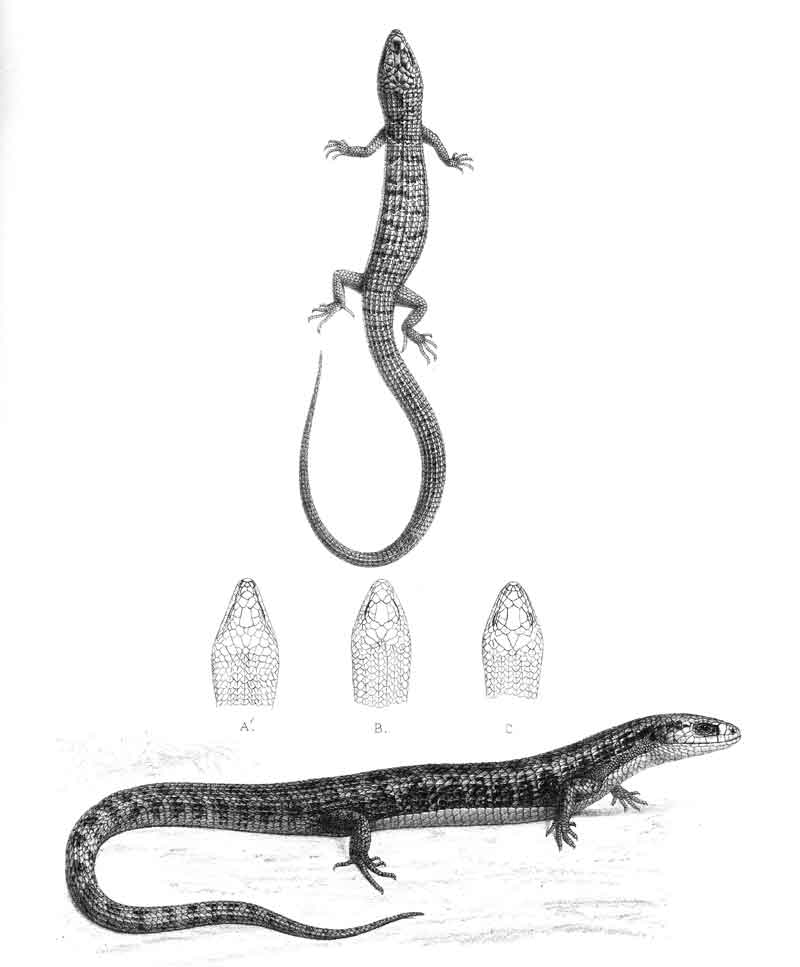
Superregnum: Eukaryota
Regnum: Animalia
Subregnum: Eumetazoa
Cladus: Bilateria
Cladus: Nephrozoa
Superphylum: Deuterostomia
Phylum: Chordata
Cladus: Craniata
Subphylum: Vertebrata
Infraphylum: Gnathostomata
Superclassis: Tetrapoda
Cladus: Reptiliomorpha
Cladus: Amniota
Classis: Reptilia
Cladus: Eureptilia
Cladus: Romeriida
Subclassis: Diapsida
Cladus: Sauria
Infraclassis: Lepidosauromorpha
Superordo: Lepidosauria
Ordo: Squamata
Cladus: Unidentata, Episquamata, Toxicofera
Subordo: Anguimorpha
Infraordo: Neoanguimorpha
Superfamilia: Diploglossa
Familia: Anguidae
Subfamilia: Gerrhonotinae
Genus: Elgaria
Species: Elgaria coerulea
Subspecies (4): E. c. coerulea – E. c. palmeri – E. c. principis – E. c. shastensis
Name
Elgaria coerulea (Wiegmann, 1828)
Holotype: ZMB 1163, collected by A. von Chamisso on 1816.
Type locality: “Brasilia” (in error); modified to “San Francisco, California” by Stejneger (1902).
Combinations
Gerrhonotus coeruleus Wiegmann, 1828: 380 [original combination]
Elgaria coerulea — Tihen, 1949: 595 [subsequent combination]
References
Primary references
Wiegmann, A.F.A. 1828. Beyträge zur Amphibienkunde (in German). Isis von Oken 21(4): 364–383. BHL Reference page.
Links
Uetz, P. & Hallermann, J. 2022. Elgaria coerulea. The Reptile Database. Accessed on 1 November 2018.
Hammerson, G.A. 2007. IUCN: Elgaria coerulea (Least Concern). The IUCN Red List of Threatened Species 2007: e.T63701A12706801. DOI: 10.2305/IUCN.UK.2007.RLTS.T63701A12706801.en
Elgaria coerulea – Taxon details on Integrated Taxonomic Information System (ITIS).
Vernacular names
English: Northern Alligator Lizard
français: Lézard-alligator boréal
The northern alligator lizard (Elgaria coerulea) is a species of medium-sized lizard in the family Anguidae. The species is endemic to the North American west coast.
Taxonomy
The northern alligator lizard was formerly known by the scientific name of Gerrhonotus coeruleus Wiegmann, 1828, but more recently has been assigned to the genus Elgaria.
Subspecies
Four subspecies are recognized as being valid, including the nominotypical subspecies.[2]
E. c. coerulea (Wiegmann, 1828) – San Francisco alligator lizard
E. c. palmeri (Stejneger, 1893) – Sierra alligator lizard
E. c. principis Baird & Girard, 1852 – Northwestern alligator lizard
E. c. shastensis (Fitch, 1934) – Shasta alligator lizard
A trinomial authority in parentheses indicates that the subspecies was originally described in a genus other than Elgaria.
The subspecies E. c. principis is one of five species of lizards in Canada.
Etymology
The subspecific name, palmeri, is in honor of American zoologist Theodore Sherman Palmer.[3]
Description
The northern alligator lizard is a medium-sized slender lizard. Adults reach a snout-to-vent length (SVL) of about 10 cm (3.9 in) and a total length (including tail) of roughly 27.5 cm (10.8 in). It has a distinct skin fold on each side, separating the keeled scales on the back from the smooth ventral scales. The skin varies in color, but can be brown and white or greenish yellow and brown. Dorsally, E. coerulea is brownish in color and often has dark blotches that sometimes blend together into bands. The throat and mouth area of some young individuals can be yellow. The belly is light gray. The eyes are dark.
Diet
The typical diet of E. coerulea includes crickets, slugs, beetles, spiders, and moths, but it will also take larger prey, such as small lizards, and will even eat small baby mice if given the opportunity.
Reproduction
The northern alligator lizard is live-bearing, producing up to 15 young (typically 4–5), between June and September.[4] During the spring breeding season, a male lizard grasps the head of a female with his mouth until she is ready to let him mate with her. They can remain attached this way for many hours, almost oblivious to their surroundings. Besides keeping her from running off to mate with another male, this probably shows her how strong and suitable a mate he is.[5]
Distribution
Range of the Northern Alligator Lizard Ranges of
E. c. coerulea,
E. c. palmeri,
E. c. principis, and
E. c. shastensis.
The northern alligator lizard occurs along the Pacific Coast and in the Rocky Mountains from southern British Columbia through Washington, northern Idaho and western Montana south through Oregon to the coastal range and the Sierra Nevada in central California. As the map shows, the different subspecies have quite different geographic ranges, with E. c. principis being the most widely distributed, whereas E. c. coerulea occurs mainly around the San Francisco area but is also found farther north into Humboldt County.
The species is widely distributed along the Pacific coast and can be found from sea level up to elevation of about 3,350 m (10,990 ft). It is found in a variety of forested habitats and montane chaparral.
See also
Southern alligator lizard
References
Hammerson, G.A. (2007). "Elgaria coerulea". IUCN Red List of Threatened Species. 2007: e.T63701A12706801. doi:10.2305/IUCN.UK.2007.RLTS.T63701A12706801.en. Retrieved 6 June 2022.
Species Elgaria coerulea at The Reptile Database . www.reptile-database.org.
Beolens, Bo; Watkins, Michael; Grayson, Michael (2011). The Eponym Dictionary of Reptiles. Baltimore: Johns Hopkins University Press. xiii + 296 pp. ISBN 978-1-4214-0135-5. (Elgaria coerulea palmeri, p. 200).
Stebbins RC (2003). A Field Guide to Western Reptiles and Amphibians, Third Edition. The Peterson Field Guide Series ®. Boston and New York: Houghton Mifflin Company. xiii + 533 pp. ISBN 978-0-395-98272-3. (Elgaria coerulea, pp. 332-333 + Plate 41 + Map 126).
"Northwestern Alligator Lizard - Elgaria coerulea principis". Californiaherps.com. Retrieved 2020-01-19.
Further reading
Boulenger GA (1885). Catalogue of the Lizards in the British Museum (Natural History). Second Edition. Volume II. ... Anguidæ ... London: Trustees of the British Museum (Natural History). (Taylor and Francis, printers). xiii + 497 pp. + Plates I-XXIV. (Gerrhonotus cæruleus, pp. 273–274).
Wiegmann AF (1828). "Beiträge zur Amphibienkunde ". Isis von Oken 21 (4): 364-383. (Gerrhonotus coeruleus, new species, p. 380). (in German and Latin).
Retrieved from "http://en.wikipedia.org/"
All text is available under the terms of the GNU Free Documentation License

